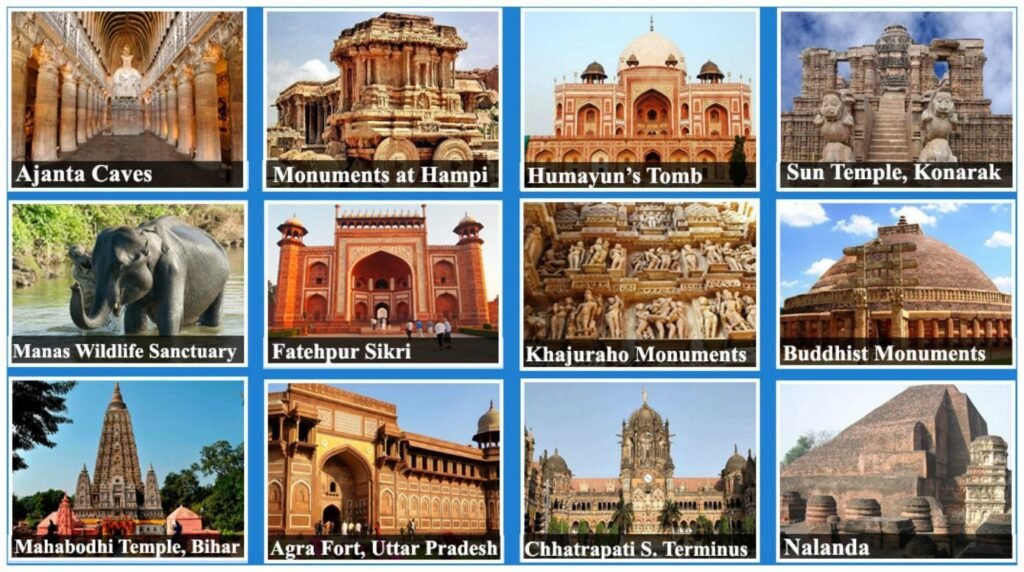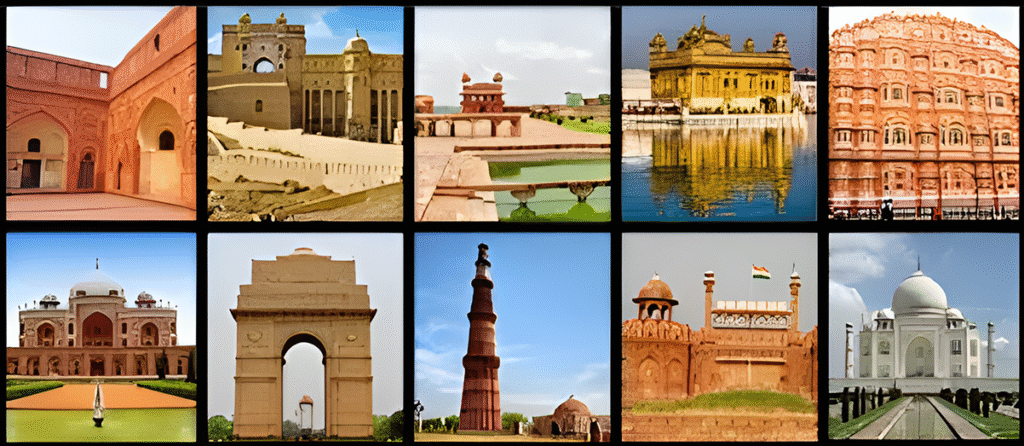Monuments of India stand as timeless testaments to a civilisation woven through centuries of creativity, devotion, conquest, and resilience. These grand structures, whether carved from stone, forged in marble, or built from red sandstone, echo the country’s history, spirituality, artistic flourish, and political ambitions, while also serving as central stages for tourism and cultural revenue. Journeying from the ancient relics of Southern India to the majestic marble mausoleum in Agra, the story of India’s monuments is as layered and vibrant as the country itself.
India, famed for its unity in diversity, is home to some of the world’s most exquisite monuments. Each structure, from medieval forts to sacred temples, ancient caves to grand palaces, is an architectural marvel and a cultural repository. These landmarks attract millions of domestic and global travellers annually, generate significant revenue, and preserve India’s historic spirit.
The Legacy and Significance of Monuments of India
Monuments of India are not just relics of the past; they are enduring narratives of empires, faiths, and dynasties. Structures such as the Taj Mahal, Qutub Minar, Red Fort, and Sun Temple are intricately entwined with India’s cultural identity, showcasing influences from Mughal, Rajput, Dravidian, and colonial eras. These monuments have witnessed battles, coronations, and spiritual awakenings, and their preservation remains a national priority.
Must-Visit Monuments of India: A Curated List
These sites represent only a segment of India’s diverse architectural treasures. From Jaipur’s pink palaces to the sacred serenity of the Golden Temple, every region boasts its jewels.
Key Details:
Entry fees and timings are subject to change, and additional charges may apply for features like night viewing or museum access.
Historical Backdrop and Evolution
Monuments of India owe their existence to successive historical epochs:
- The ancient world: Buddhist stupas, such as Sanchi (3rd century BCE), rock-cut caves (Ajanta & Ellora), and Ashokan pillars, showcase early statecraft and the spread of Buddhism.
- Medieval period: Mughal emperors and Rajput chieftains constructed spectacular fortresses, palaces, and mausoleums, blending Persian, Islamic, and Hindu architectural idioms.
- Colonial era: The British reign saw the emergence of Indo-Saracenic structures, including the Victoria Memorial, Gateway of India, and others.
Tourism: Footfall, Revenue, and Infrastructure
Monuments of India remain central to the nation’s tourism industry. In 2024-25, the sector saw an enormous rebound:
- The Taj Mahal attracted nearly 6.9 million visitors, including over 600,000 foreign tourists.
- Revenue from entry ticket sales for centrally protected monuments (ASI) reached impressive highs. The Taj Mahal generated ₹297 crore in five years, dwarfing other heritage sites.
- Tourism contributed over ₹15.73 lakh crore ($192 billion) to India’s GDP in 2023-24, accounting for approximately 5.22% of the total economy.
- In 2024, the nation welcomed about 20.57 million international tourist arrivals, a clear sign of its enduring global appeal.
Government efforts focus on sustainable tourism, digital ticketing, multilingual guides, and diligent conservation to ensure long-term preservation and accessibility.
Location, Routes, and Accessibility
Most major monuments of India are well-connected through road, rail, and air networks:
- Agra (Taj Mahal, Agra Fort): Easily accessed via New Delhi by train (Gatimaan Express, Shatabdi) or by road (Yamuna Expressway).
- Delhi (Qutub Minar, Red Fort, India Gate): Well-served by an international airport and metro.
- Jaipur (Hawa Mahal, City Palace, Amer Fort): A short flight/drive from Delhi or Mumbai.
- Aurangabad (Ajanta, Ellora Caves): Flights and trains available from Mumbai and Pune.
- Amritsar (Golden Temple): It has its own airport and direct trains from metro cities.
- Konark (Sun Temple): Reachable from Bhubaneswar by road.
Major tour operators and government agencies offer guided circuits connecting these prominent sites for ease of travel.
Culture and Symbolism
Monuments of India weave myth, religion, and philosophy into their stones:
- Temples like Brihadeeswarar and Sun Temple depict celestial myths and local folklore in intricate carvings.
- Mosques and mausoleums highlight spiritual unity and the Mughal quest for paradise on earth (e.g., symmetry and calligraphy at Taj Mahal).
- Forts and palaces narrate tales of valour, treachery, and grandeur, from Rajput strongholds to colonial residencies.
Annual cultural festivals and light-and-sound shows at many monuments of India relive legends and invite locals as well as tourists into India’s living history.
Conservation Challenges and Initiatives
While Monuments of India are global icons, they face challenges:
- Pollution, over-visitation, and weathering threaten structural integrity, especially at heavily visited sites like the Taj Mahal.
- Government campaigns, UNESCO partnerships, and private CSR initiatives provide funds and technology for conservation and eco-friendly visitor management.
- Efforts include laser cleaning for marble, regulating tourist numbers, and undertaking archaeological research for restoration.

Complete List of Must-Visit Monuments of India
- Taj Mahal (Agra)
- Qutub Minar (Delhi)
- Red Fort (Delhi)
- India Gate (Delhi)
- Hawa Mahal (Jaipur)
- City Palace (Jaipur)
- Amber Fort (Jaipur)
- Jaisalmer Fort (Rajasthan)
- Mehrangarh Fort (Jodhpur)
- Gateway of India (Mumbai)
- Ajanta & Ellora Caves (Maharashtra)
- Victoria Memorial (Kolkata)
- Sun Temple (Konark)
- Charminar (Hyderabad)
- Golconda Fort (Hyderabad)
- Fatehpur Sikri (Uttar Pradesh)
- Sanchi Stupa (Madhya Pradesh)
- Khajuraho Temples (Madhya Pradesh)
- Brihadeeswarar Temple (Tamil Nadu)
- Mysore Palace (Karnataka)
- Hampi Monuments (Karnataka)
- Lotus Temple (Delhi)
- Chhatrapati Shivaji Maharaj Terminus (Mumbai)
- Rashtrapati Bhavan (Delhi)
- Jama Masjid (Delhi)
- Chittorgarh Fort (Rajasthan)
- Humayun’s Tomb (Delhi)
- Jantar Mantar (Delhi)
- Rani ki Vav (Gujarat)
- Golden Temple (Amritsar)
Travel Tips and Recommendations
- Opt for weekday visits or early mornings to avoid crowds at popular sites.
- Buy digital tickets in advance through official websites to skip queues.
- Respect local customs, remove shoes where indicated, dress modestly, and avoid touching carvings or murals.
- Plan circuits (Golden Triangle: Delhi-Agra-Jaipur) for efficient travel between multiple monuments.
The Future Monuments of India
Monuments of India, which bridge millennia and modernity, will continue to draw dreamers, history seekers, and global wanderers. As the government promotes conservation and sustainable tourism, these living legacies are poised to inspire future generations.
FAQs About Monuments of India
Which is India’s most-visited monument?
The Taj Mahal in Agra is consistently India’s most-visited monument, with approximately 6.9 million visitors in the 2024-25 fiscal year.
How do Monuments of India contribute to tourism revenue?
Entry tickets to ASI monuments generate substantial revenue, with the Taj Mahal alone bringing in ₹297 crore over a five-year period. The sector’s total GDP contribution exceeds ₹15 lakh crore annually.
Are these monuments of India accessible to travellers with disabilities?
Major sites, such as the Taj Mahal, Red Fort, and Qutub Minar, offer wheelchair services and ramps; however, accessibility may vary at older or cave-based monuments. Always check facilities in advance.
Which is India’s oldest monument that still attracts tourists?
The Sanchi Stupa (3rd century BCE) near Bhopal and the Ajanta Caves (2nd century BCE–6th century CE) are among the oldest, attracting history buffs worldwide.
Are photography and videography allowed at the Monuments of India?
Most monuments permit general photography (without flash or drones), but certain restricted zones, especially within mausoleums or sanctuaries, prohibit the use of cameras. Tripods, drones, and commercial shoots require special permission.
What are the best times to visit the top Monuments of India?
October to March is generally ideal due to pleasant weather, especially for sites in northern and central India. Southern and western monuments can be visited year-round, but it is best to avoid peak summer months.
Which monument of India is considered a wonder of the world?
The Taj Mahal is recognised as one of the New Seven Wonders of the World.
